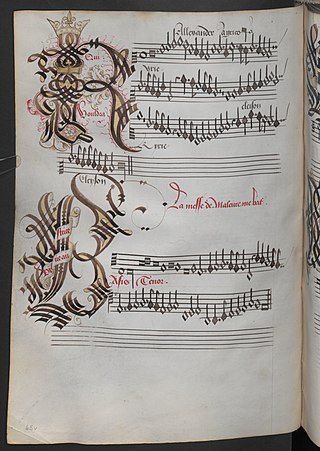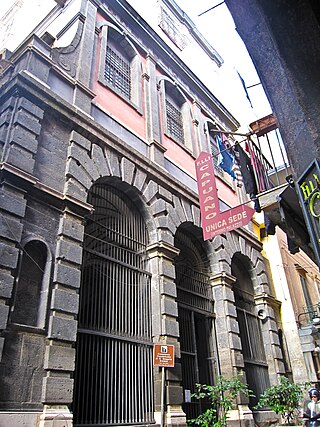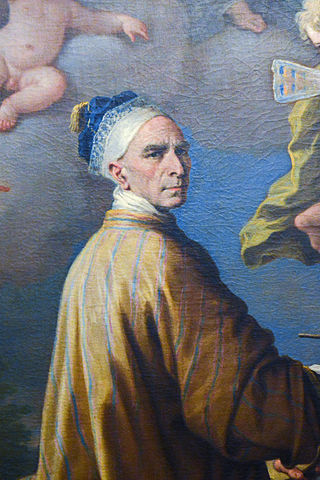Related Research Articles

Ferdinand I, also known as Ferrante, was king of Naples from 1458 to 1494.

Luca Giordano was an Italian late-Baroque painter and printmaker in etching. Fluent and decorative, he worked successfully in Naples, Rome, Florence, and Venice, before spending a decade in Spain.
Aniello Falcone or Ancillo Falcone was an Italian Baroque painter, active in Naples and noted for his painted depictions of battle scenes.

Sebastiano Conca was an Italian painter.

Alexander Agricola was a Netherlandish composer of the Renaissance writing in the Franco-Flemish style. A prominent member of the Grande chapelle, the Habsburg musical establishment, he was a renowned composer in the years around 1500, and his music was widely distributed throughout Europe. He composed music in all of the important sacred and secular styles of the time.

Giovanni Lanfranco was an Italian painter of the Baroque period.

Francesco Solimena was a prolific Italian painter of the Baroque era, one of an established family of painters and draughtsmen.

San Gregorio Armeno is a church and a monastery in Naples, Italy. It is one of the most important Baroque complexes in Naples. The church is located on a street of the same name just south of Via dei Tribunali and a few blocks south of the church of San Paolo Maggiore, Naples

Paolo de Matteis was an Italian painter.

Abate Andrea Belvedere was an Italian painter of the Baroque period.

Giuseppe Simonelli was an Italian painter, active in a late-Baroque style.

Attilio Pratella was an Italian painter, noted for his landscapes and realistic scenes of Neapolitan life.

Giacomo Farelli was an Italian painter active in Naples.

The Basilica of Santa Maria della Sanità is a basilica church located over the Catacombs of San Gaudioso, on a Piazza near where Via Sanità meets Via Teresa degli Scalzi, in the Rione of the Sanità, in Naples, Italy. The church is also called San Vincenzo or San Vincenzo della Sanità, due to the cult of an icon of San Vincenzo Ferrer, also called locally O' Monacone.

Santa Maria degli Angeli a Pizzofalcone is a Baroque-style church in Naples, Italy.

Santa Maria Egiziaca a Forcella, also known as the Church of Santa Maria Egiziaca all'Olmo, is a Baroque-style, Roman Catholic church located in the quartiere di Forcella, in the city of Naples, Italy.
Tommaso Martini was an Italian painter of the late-Baroque period.

Regina Diaz is an opera in two acts composed by Umberto Giordano to a libretto by Giovanni Targioni-Tozzetti and Guido Menasci. It premiered on 5 March 1894 at the Teatro Mercadante in Naples. The libretto is based on Lockroy's and Edmond Badon's Un duel sous le cardinal de Richelieu, which was also the source of Donizetti's 1843 opera Maria di Rohan, although the setting for Giordano's version was moved from 17th-century Paris to 18th-century Naples. The opera was a failure at its premiere and withdrawn after the second performance. Giordano's patron and publisher, Edoardo Sonzogno, blamed the failure on the poor libretto. Giordano blamed it on Sonzogno's interference in the production.

Aniello Ascione was an Italian painter of still lifes. He is regarded as an important representative of the Flemish style of Baroque still life painting and a follower of the Flemish painter Abraham Brueghel who worked in Naples in the final quarter of the 17th century.

Gian Giordano Orsini, IV Lord of Bracciano was an Italian nobleman and condottiero. He married Felice della Rovere and was the son-in-law of Pope Julius II.
References
- This article incorporates text from the article "AMENDOLA, Ferrante" in A biographical history of the fine arts by Shearjashub Spooner, an 1873 publication now in the public domain.
- ↑ Garollo, Gottardo (1907). Ulrico Hoepli (ed.). Dizionario biografico universale. Editore Libraio della Real Casa, Milan. p. 81.